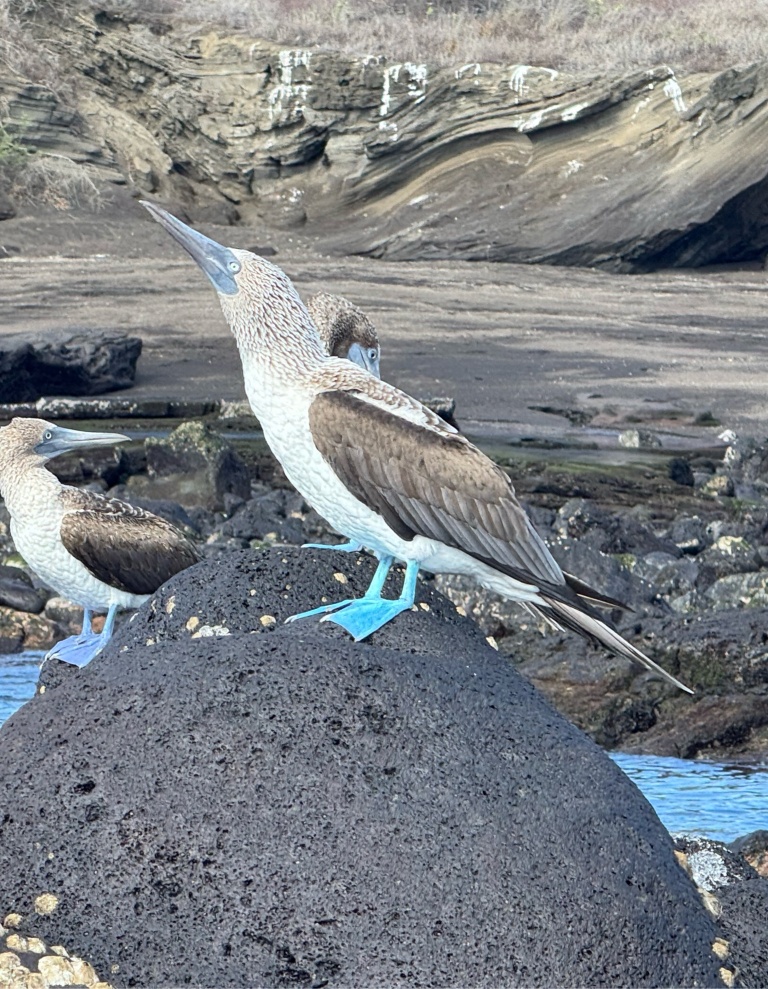
Quito at Night
As we flew over the Andes mountains of northern South America a beautiful vista of twinkling lights awaited us as Quito spread its border like a welcoming blanket.

Making Chocolate
We made a pre-lunch visit to Minka Chocolate where we participated in a chocolate making class. Tom and I have made chocolate before, but this time we did a much tastier and decidedly prettier job! \240We learned that some of the best cacao is grown in Ecuador, but the secret is truly in the manufacturing method. After cacao beans are harvested, they are fermented in the white flesh of the fruit for about a week, then cleaned, dried and roasted to remove the shell. The nibs of chocolate that are left are then ground into a thick paste called cacao mass or cacao liquor, to release the cacao butter to make it smooth. Afterwards, the mixture is refined by adding sugar and other flavors and then undergoes a process called conching, where the mixture is heated for days to improve texture, reduce acidity and accent the flavor. Finally, the chocolate is cooled and reheated to create a small, shiny texture that will snap when pressure is applied. We finished with a decadent hot chocolate!





Iglesia de la Compania de Jesus
Constitution of this baroque style church began in 1605 Ana continued till 1765. The exterior of the church is carved from volcanic stone while the interior is overlaid in gold leaf.


All of the gold is gold leaf making an ethereal interplay with the sunlight!

We finished our tour of Quito with a stroll down the Avenue of 7 Crosses. There are truly 7 cathedrals within a few blocks in this section. The concentration of active, historic, religious buildings in Quito have resulted in Quito being a UNESCO Heritage site. \240We were fortunate to be able to tour the Jesuit cathedral which is almost completely covered in gold leaf on the inside. \240It is the most ornate cathedral I’ve seen in Central or South America! Well, except for the crypts- which were typical cement and stone - and were strangely open for viewing the bones of ancient religious nobility.
A Day in the Old Quito City
We wandered the streets of old town Quito marveling at the colorful displays of grains and fruit in the shops. Being Sunday, many of the shops were closed, but there were plenty of street vendors! The temperature was a cool 65 and was very pleasant and we enjoyed the town! The town is very safe, with police officers strolling amongst the town people. Most of the churches were busy holding mass throughout the day, but we caught a glimpse of the Winged Virgin Mary of Quito on top of a hill. The original winged virgin is only 5 ft tall, made of wood and encased in jewels and precious metals. She resides in the Cathedral of San Francisco.


Grain for sale!




Colorful streets of Quito

San Francisco Square
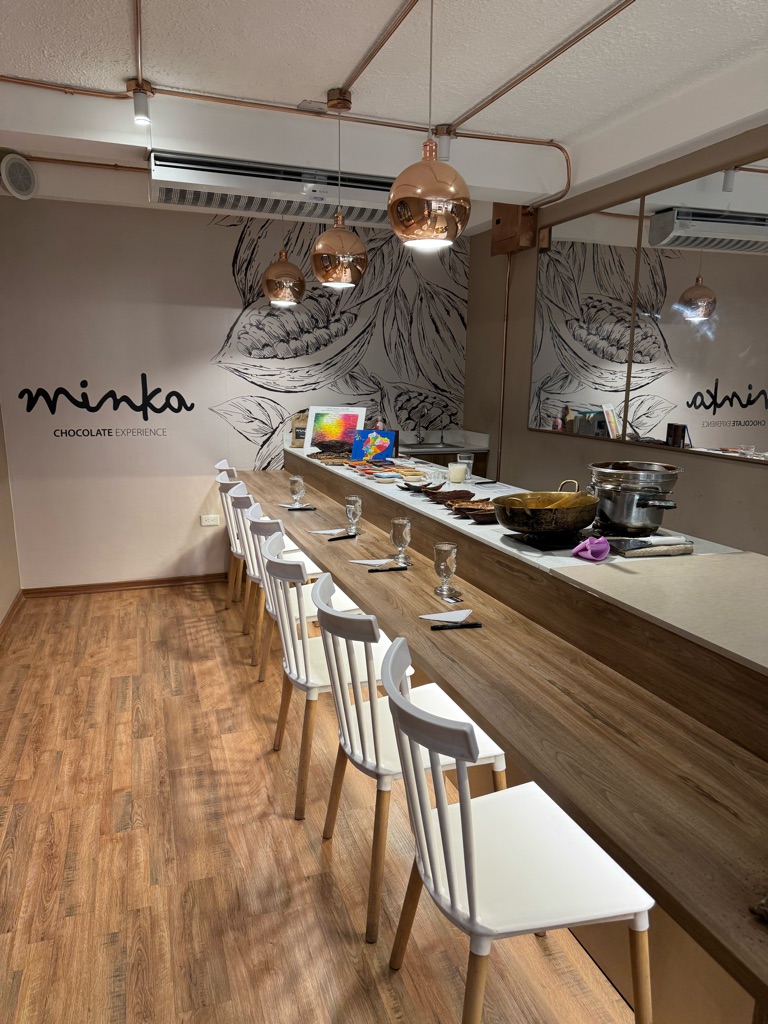
Minka Chocolate Shop

Tom getting \240ready to pour the chocolate onto the slab

Dana melting the chocolate.

Dana tempering the chocolate
We discovered that the trick to making smooth, shiny chocolate that is easy to break off is the tempering or cooling process!

The Winged Virgin Mary on top of the hill

The Winged Virgin Mary of Quito

Bob and Tom enjoying Hot Choclate

San Francisco Square




Quito, Ecuador
At 9176 feet elevation in the Andes, the capital city of Equador is surprisingly modern. After an early breakfast, we traveled to the teleferico tram that took us up to an overlook at the top of Pichincha Volcano (which last erupted in 1999). Well we almost made we almost made it to the top! We made it to 13,800 feet, but opted to skip the final 2000 ft uphill hike to the very top at 15,600 feet. Our Florida sea-level lungs were aching!!

The tram that carried us up for an overview of Quito provided a view of the surrounding volcanoes. Some folks had the option to climb another 1500 feet to the top of the volcano … but we opted to just enjoy the view from where we were!

Teliferico Tram
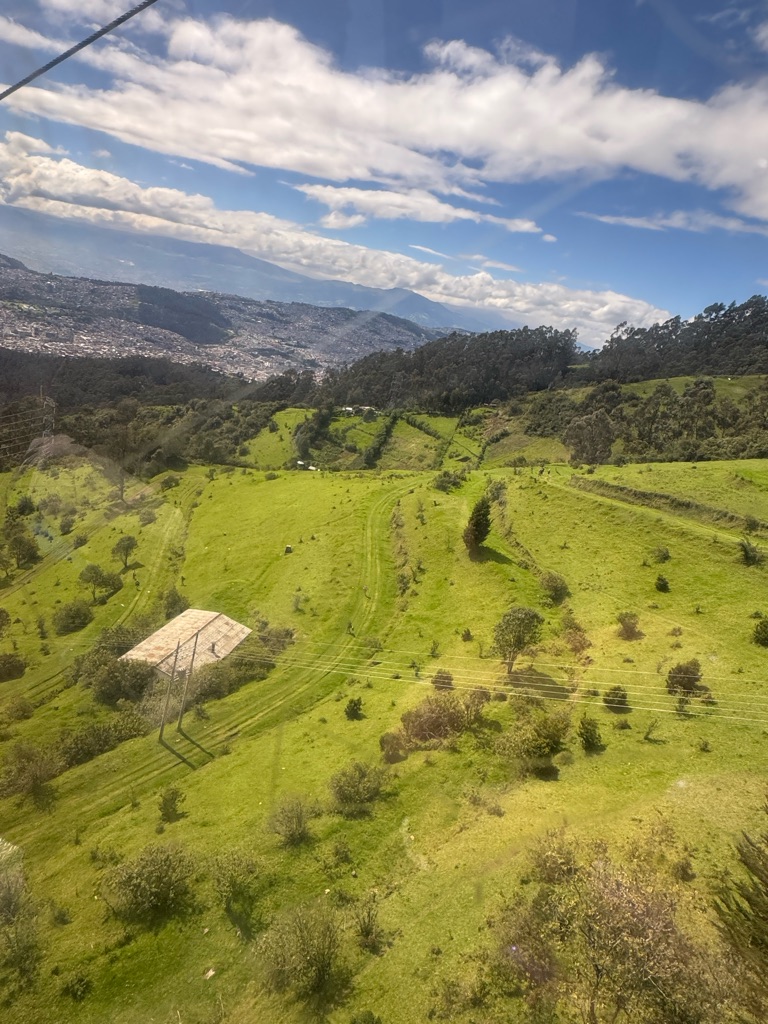
View from the Top


Bob, Beth,Dana and Tom

Beth and Tom

Quito

The confusing (and we’re convinced, dangerous) state of electricity in Quito!
The Orchid Garden
Over 4200 species of orchids grow in Ecuador, accounting for 25% of all species in the world! Many species are endemic to Ecuador with 1700 found no where else in the world! And Mindo, in the cloud forest, is one of the hot spots for orchids! We toured a private garden with hundreds of orchids. The lovely owner told us their names and characteristics ( all in Spanish which we did not understand) but we enjoyed her excitement \240and the fruits of her labors!










Ecuadorian Arabica Coffee
Ecuador produces excellent arabica coffee in the lower highlands on the sides of the Andes. Of course we had to taste a few varieties! We had to get some caffeine in us for the 2 hours of winding mountain road that we traveled to get to the cloud forest town of Mindo.

Adorable Coffee Shop

Delicious Cappuccino
The Cloud Forest and Butterfly Garden
This beautiful garden is home to 25 species of butterflies and many delicious (at least to the butterflies) flowers and plants. \240But this was just a tiny example of the 4000 - 5000 species found throughout Ecuador! \240While wandering among these voluminous insects, we were able to view 3 of the 4-stage life cycle of butterflies (egg, caterpillar, pupae, butterfly). \240We didn’t see any eggs as they were carefully sequestered to protect the hatching. We did see many magnificent Blue Morpho butterflies, but they were seldom still enough to photograph. \240The Blue Morpho is a large butterfly with striking iridescent blue wings. \240Fortunately , we caught one taking a rest and got some good photos. We also saw a butterfly with translucent wings! Overall this was a wonderful treat during our visit to Mindo!


Butterfly emerging from cocoon.

More butterfly emerging from cocoons.






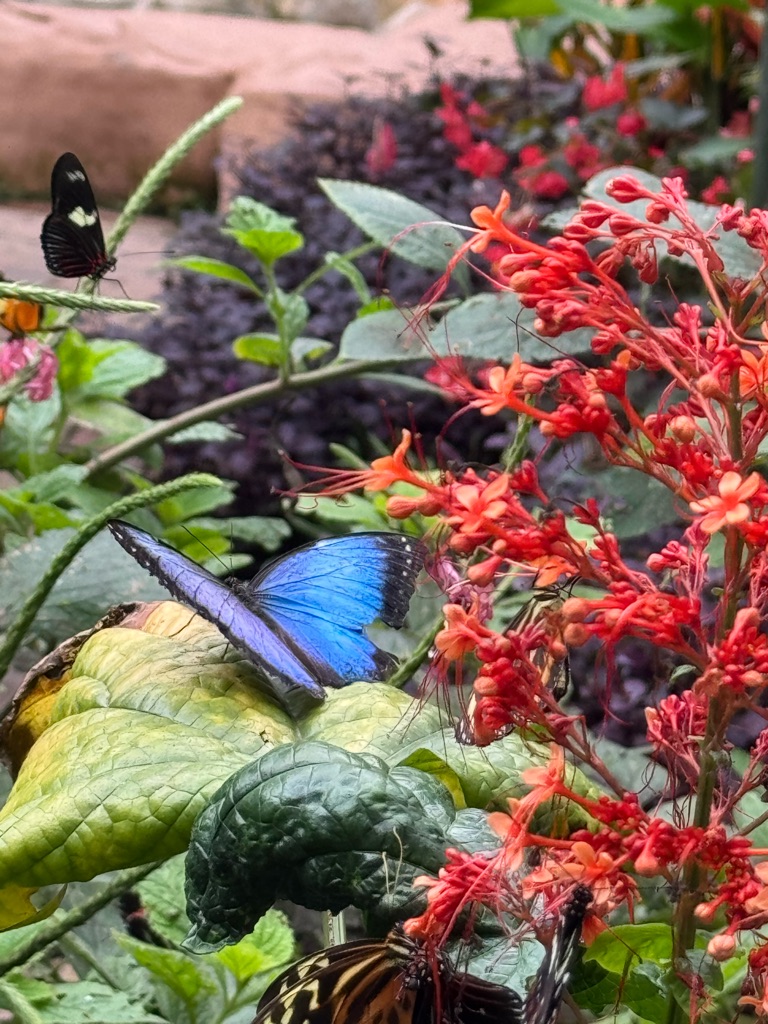

Galápagos Islands
The Galápagos Islands straddle the equator in the Pacific ocean about 600 miles off the shore of Ecuador, who claims them. They occupy a land mass half as large as Hawaii. The most famous visitor to the islands was Charles Darwin who, in 1835, spent 5 weeks of his 5 year journey aboard the HMS Beagle, chronicling the diversity of life on the islands.
The Galápagos formed as independent shelf volcanos, many of which eventually merged together forming larger islands. Because it had never been attached to any continent, and the distance to other continents is so great, the life forms that made it to the islands via floating logs or seaweed or by air eventually evolved to become endemic species found no where else in the world.

Entrance to Baltra Airport
Baltra has the only public airport in the islands and very little else. The first airport was built by the US during WWII when the Galápagos Islands were used to stage and defend US Pacific war initiatives.

Our Avianca Plane

Entrance Documents
97% of the Galápagos Islands are a national park. We had to pay around $20 \240to be able to enter the park as well as have a valid passport. We had to leave the coffee we bought in Ecuador behind at the hotel as no food, seeds, or apparently processed coffee is allowed in! We later discovered that coffee is grown in the Galapagos, so we bought some here!
The M/Y Grace
Our ship for the week, M/Y Grace, was built in 1928 as the M/Y Monaco. In WWII, it was requisitioned by the British Royal Navy and was used as an anti-submarine patrol vessel. After the war it returned to private ownership and had several owners and renovations. In 1956, it was gifted by Aristotle Onassis to Princess Grace and Prince Ranier as a wedding present.

Our Bedroom

Bathroom
In the later years, the Grace changed ownership a few more times, finally being acquired by Quasar where now it is operated as a luxury expedition ship in the Galapagos. \240We are loving the antique ship style with 8 suites accommodating 16 passengers. Recently renovated in 2022, it provides luxury amenities and delicious chef prepared meals! Totally the best way to see the Galapagos!

M/Y Grace
The ship may have old, classic lines compared to the newer yachts anchoring with us, but the old lady is fast, steady, and exudes elegance!



Hot Tub
We found the hot tub particular pleasant after snorkeling in the cool waters of Galapagos. (OK, cool is a relative term, but we’re from Florida and this water is like swimming in the Gulf of Mexico in February!)
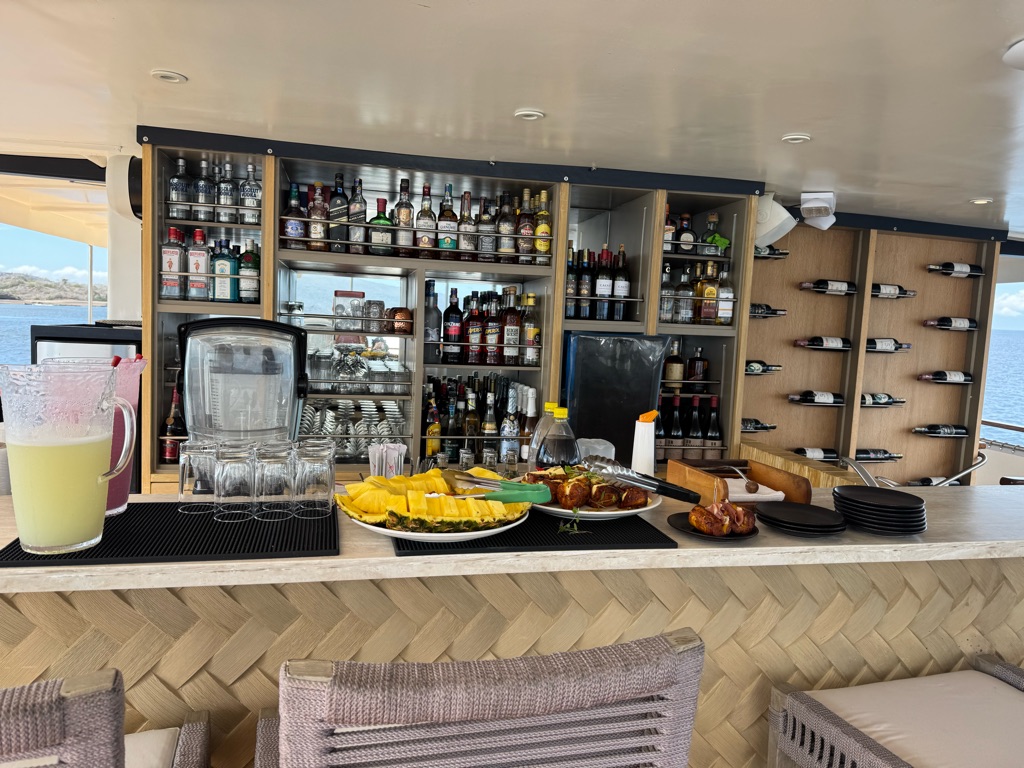
The Bar
Our evening hangout was the bar, situated above the outdoor dining area and just steps away from our room.

The Salon
In dreary weather, the salon offered a cheery place to hang.

The Alfresco Dining Room
All of our meals were served here, sans the 16 passengers changed tables frequently so we could get to know each other quite well.

Afternoon Gathering

Example of our Meals aboard M/Y Grace
Santa Cruz Island - Bachus Beach
After landing on Baltra Island, we sailed a short distance to Bachus Beach for our first introduction to Galapagos fauna - in this case Sally lightfoot crabs and American flamingos! The island’s white beaches are made from eroded coral with sharp, black lava outcroppings reaching into turquoise water. \240The island got its name from the US Navy which beached 2 barges on the island during WWII. Fast forward to today and the Spanish word for barges was shortened to be bachus. The bright orange and blue Sally crab is a stunning site on the black lava rocks. They are the most common crab in the Galapagos and we will surely see them again. But Wow - what a picture! And then we saw the flamingos! There are around 500 flamingos in the Galapagos and the four we watched were spectacular! \240The island is also a nesting ground for sea turtles and we saw many mounds that we thought to be nests. But our guide, Hernman, mentioned that the Galapagos has thousands of turtle nests each year so they don’t bother to mark them.


Sally Lightfoot Crab

American Flamingos

Flamingos

Brackish Pond

Genovesa Island - Prince Phillips Steps
Described as ‘the birding island’, we started our hike early (6:30am) to catch the birds being most active (and to take advantage of cooler temperatures). Upon climbing up about 35 steps hewn into the rock, we were immediately confronted with Red Footed Boobies, Nazca Boobies, and Great Frigate Birds - the males displaying the huge, puffed up, red throat that the species OSS known for. S ome of the Nazca Boobies were busy displaying mating rituals and some were already on the nest of 1 or 2 eggs. We caught 1 couple in the ‘act’! \240
We’re at the start of the rainy season, and the birds are getting busy! We discovered that the brightness of the beak and feet of the Boobies indicates a good breeding male, and for the Great Frigate Birds, it’s all about the size (of the throat pouch). Red Footed Boobies are gray -brown birds with … you guessed it … bright red webbed feet! But we were fortunate to see a rare one with white plumage. Apparently only 7% of the population have this white gene.

Prince Phillip’s Steps

Nazca Boobies
Known for their striking white plumage with a black edge around the wings, gray feet and yellow to bright orange beaks, these birds were giving us quite the mating display!

Mature Female Frigate Bird

Immature Frigate Bird

Dana and a Nazca Boobie

Red-footed Boobie
The brownish-gray feathers are barely noticed between the brilliant red webbed feet and bright blue beak! Red-footed boobies live throughout the tropics but close to 500,000 live in the Galapagos, most of them on this island!

Red-footed Boobie
The Red-footed Boobie is the only Boobie that nests in trees. Its webbed feet are uniquely jointed with claws on the ends to allow them to grasp branches.

The barren lava terrain is ideal for short-eared owls.
We looked hard but couldn’t see the owls hidden in the crevices. Can you?

Nazca Boobies
Gettin Jiggy With It!

More Boobie Mating
The mating ritual of Nazca Boobies is short but sweet. The male collects sticks for a nest (of a sort), and hopes a female will come stand on it. If she selects him (usually choosing the male with the brightest orange beak), the male then brings her sticks for the nest and if she deems him worthy … the deed is done.

Nazca Boobie on nest
A week or so later 1 - 2 eggs are laid. Both parents incubate the eggs, but only 1 chick will survive. The oldest, largest chick is usually more aggressive and typically kills the smaller chick.
Sunset and Sea Lions- Darwin’s Bay
We returned to Genovesa Island in the late afternoon for a stroll along the beach and some spectacular sunset pictures. \240We saw lots of sea lions basking on the beach in the late afternoon sun. We also got a rare treat to see a just-born baby sea lion just a few minutes old! We saw many of the same birds that we’d seen on the morning walk, but they were bathed in golden light making their colors more vibrant!

Sea Lion Circle

Swallow-tail gull
This gray and white gull with red feet and a red ring around the eye is unique in that it is the only nocturnal seagull feeding entirely at night.

Young Sea Lion

Immature Frigate Bird

Mature Male Frigate Birds
The male Frigate Bird puffs out the right red gular sac on his throat with air to attract a female. The bigger the pouch, the better the chance to attract a mate. (For Frigate Birds, size matters!)

An Impressive Frigate Bird Gular Sac Pouch!

Bob and Beth

Half of our group!

Sunset Over the Tidal Pools


Mamma Sea Lions and Baby

Mamma Sea Lion and newborn baby

The chase!
These guys arefrolicking in the tidal pool!

The illusion bird!
This young sea lion is chasing a bird! You might not notice the bird as it stays just far enough away. Hilarious!
Santiago Island - Puerto Egars
We traveled overnight to awake at a new island with new wildlife. On our way to shore we spotted our first Blue-Footed Boobies! The blue of their feet is determined by their diet. The more algae to they add to their fish diet, the more turquoise their feet. And the brighter the feet, the more ladies!

Marine Iguana

Poison Apple Tree
Everything about the poison apple tree is poisonous. Eating 2 small apples is enough to kill a human, but the tortoises love them. The poison in their leaves and branches do not seem to harm the birds or other animals in the Galápagos.
Strolling along the tide pools found in the lava rock, we came across baby sea lions and one baby fur seal tucked into crannies, sleeping and waiting for their mothers to return from fishing in the sea. The moms are gone for as long as 3 days leaving the babies by themselves with just a lone male patrolling the shore to keep them safe. We also saw marine iguanas and I captured one climbing out of the sea to feed on algae growing on the lava. \240There is very little vegetation on these islands, but we spotted a poison apple tree (which are poisonous to humans but are delicacy for Galapagos tortoises) and several types of cactus - which apparently the tortoises like better than the poison apples - spines and all!

Blue-footed Boobies

Galápagos Brown Pelican and Black Lava Beach

Young Galápagos Sea Lion
Our guide, Diego, told us that we must be very specific when we refer to sea lions. We cannot call them ‘seals’ or they get very offended!!

An Itchy Nose
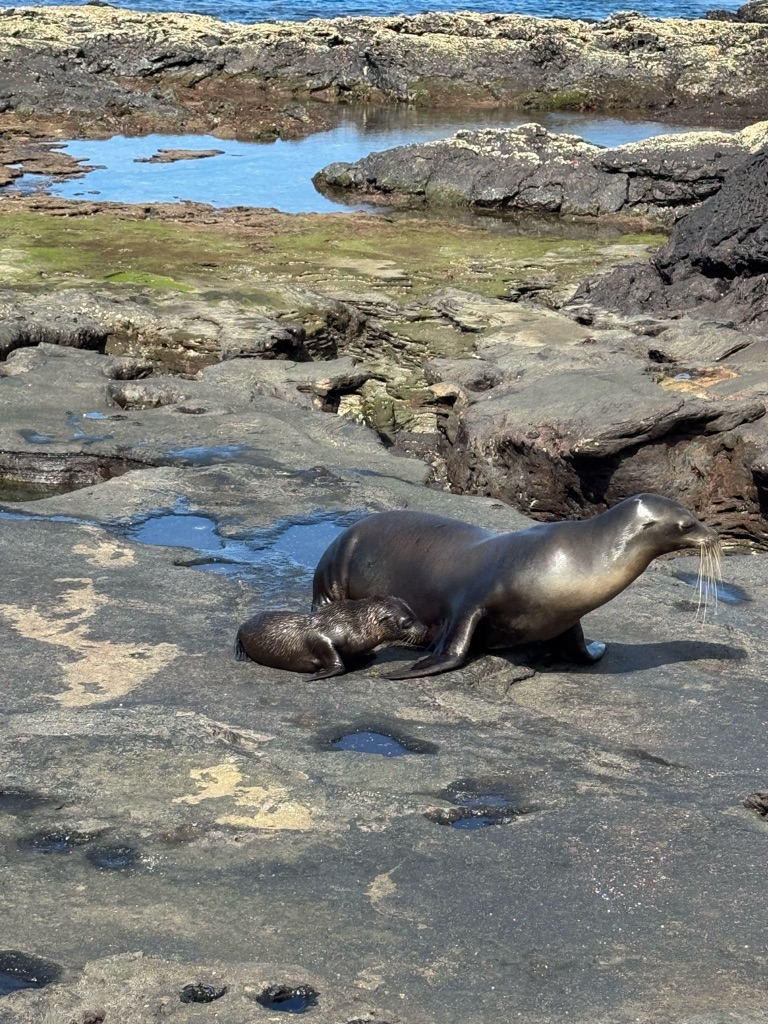
Mamma and Baby

Fur Seal
Most of the sea mammals we see in the Galapagos are sea lions, but this cute fuzzy fur baby with the large eyes is a fur seal.

Beth Found a Crab!

Tom and His Prickly Pear Cactus!

Sea Lion trying to get comfortable

Marine Iguana
This guy almost blends in with the algae he is eating!

Tom and Dana
Isabela Island
Today was spent at Isabela Island. It’s the largest of the Galápagos Islands. If you look at a map, it’s the island that looks like a sea horse. Today, we were at the mouth of the seahorse in the morning and at the stomach section in the afternoon. \240We took several panga rides along the cliffs in the morning and afternoon and saw marine iguanas ( I got a good video of one jumping into the sea and swimming) \240flightless cormorants, sea turtles, sea lions, golden rays, and penguins (I got a good video of these two!)

Penguins Sunning

Marine Iquana Swimming

Our Dingy Friends

Sea Cliffs with Algae and Barnacles
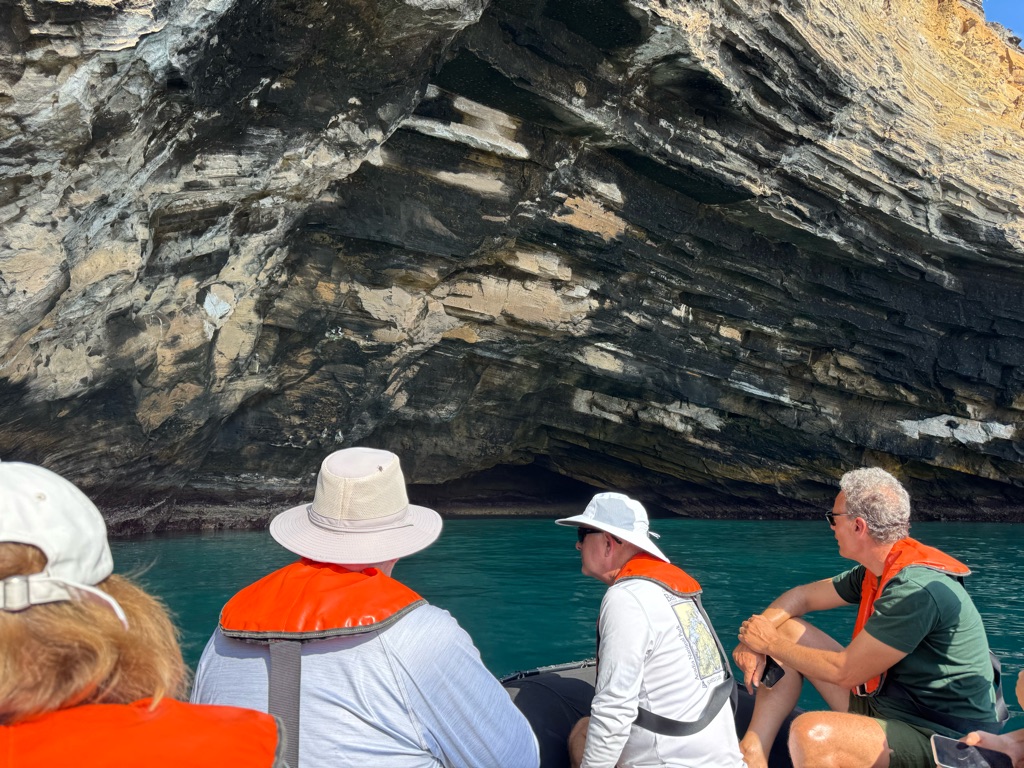
Expedition Learning

Gold, Green and Red Algae
The walls of this cliff side sea cave were covered in multicolor algae. It was as if we had entered a Kaleidoscope!

Male Marine Iquana
The males have a large dorsal fin that runs along his back. (This makes him attractive to females!). Notice the white on his head. The iguanas feed on algae growing underwater along the shore. In doing so, they consume a lot of salt water. To rid themselves of the salt they’ve developed special glands that filter the salt. Every now and then they will ‘sneeze’ salt out of their nose. It often lands on their head, making it appear white.

More colorful algae

Flightless Cormorant

Big Ol’ Iguana

Galápagos Penquin
This area of Isabela Island is just slightly north of the equator, making these penguins the one penguin species that exist north of the equator!
Snorkeling Pics
We’ve mostly seen Pacific Green Sea Turles while snorkeling. They are the primary turtles who nests in the Galapagos and they lay thousands of nests on these islands. The males can be distinguished by their long tail. They have can grow to be quite massive but are graceful underwater!

Pacific Green Sea Turtle

Skimming the Top
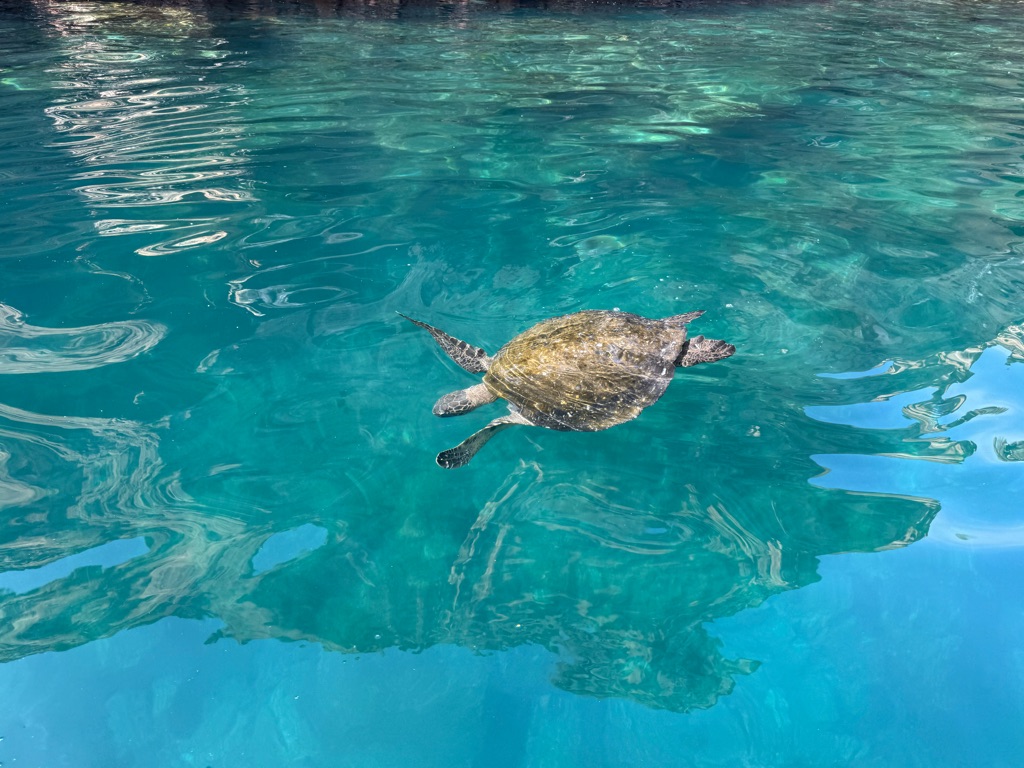
Catching Some Sun!

Green Sea Turtle

Pacific Green Sea Turtle

Galapagos Flightless Comorant
There are 40 different species of cormorants throughout the world and they all fly, except these. When they landed in the Galapagos thousands of years ago, they had no pressure, no predators, and plenty of food in the sea. So their wings shrank to mere vestiges of what they used to be and their leg muscles developed like an NFL linebacker. They are now great swimmers!

Hammerhead Sharks
We didn’t want to get close enough for a clear picture!

Marine Iguana
Feeding on algae under the sea.
Isabela island
We dingied ashore to the mangrove to walk through the poison apple grove ( all the parts of the gorgeous tree from roots, to the trunk, leaves, and fruit are poisonous to humans) in search of giant Galápagos tortoises. We found several small ones and a couple of huge ones. (Galapagos tortoises enjoy the poison apple fruit and tolerate it well. Some believe they eat them to rid themselves of intestinal parasites.
Interspersed between the tortoises were huge golden land iguanas. These guys are larger than the marine iguanas this year, being well fed on vegetation. \240Hermit crabs scrambled along the sand between all these massive creatures completely disinterested in these huge reptiles that could have smashed them into sand themselves!

Hermit Crab
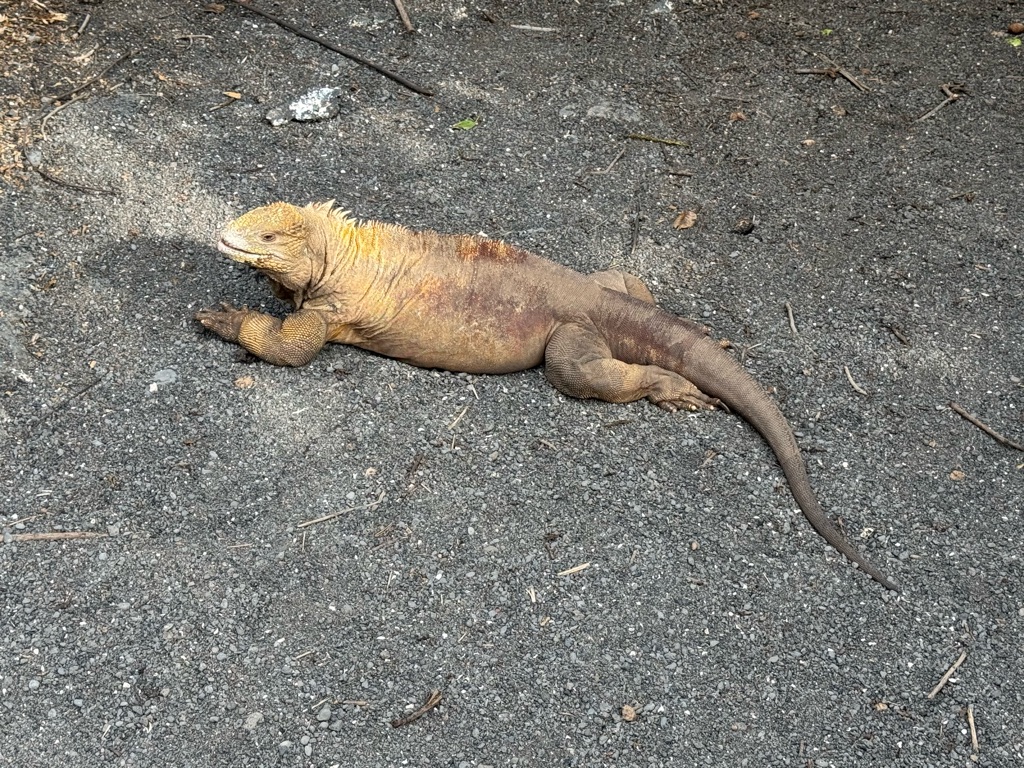
Galapagos Land Iguana
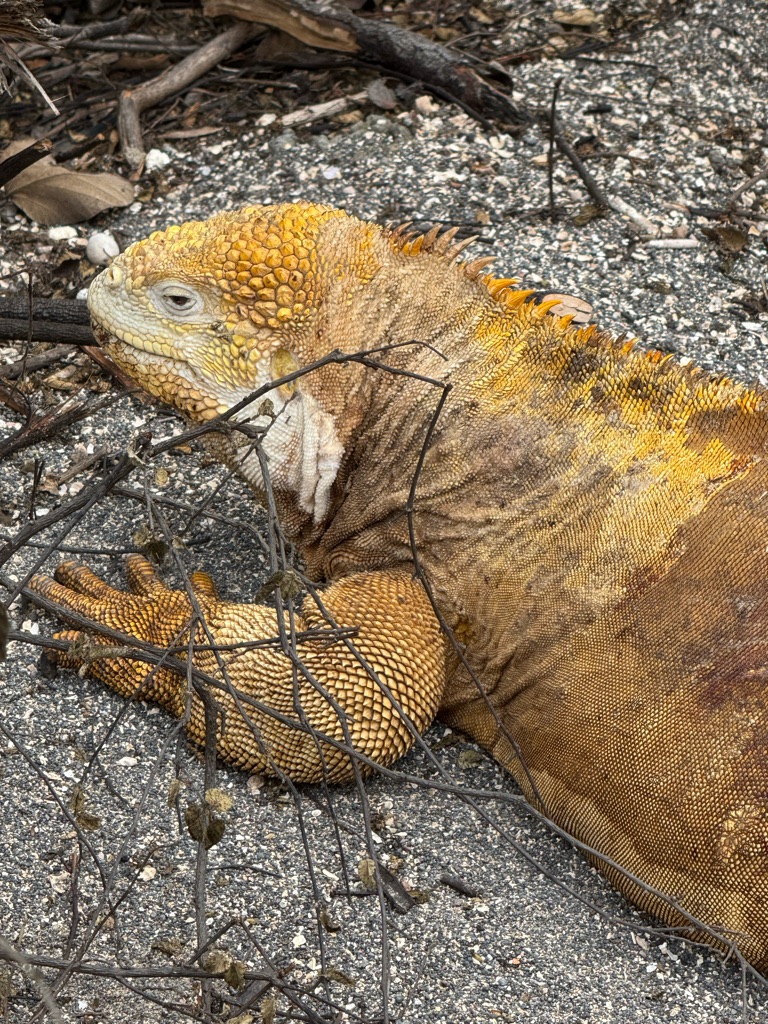
Close of Golden Rod

Small Galapagos Tortoise

Huge Galapagos Tortoise

He prefers his left side!



Munching on Poison Apples …. Yum!

Show Gown at the Ol’ Poison Apple tree

Going for a walk about
This fellow barely missed my toes!
Isabela Island - Puerto Villamil
The only settlement on the largest island in the Galápagos, about 3500 people, live here. That is because there is no source of fresh water on the island. The towns needs are met by desalination machines.
In the middle of the town is a brackish pond where 7 flamingos live. We grab some great pics against the overcast sky!

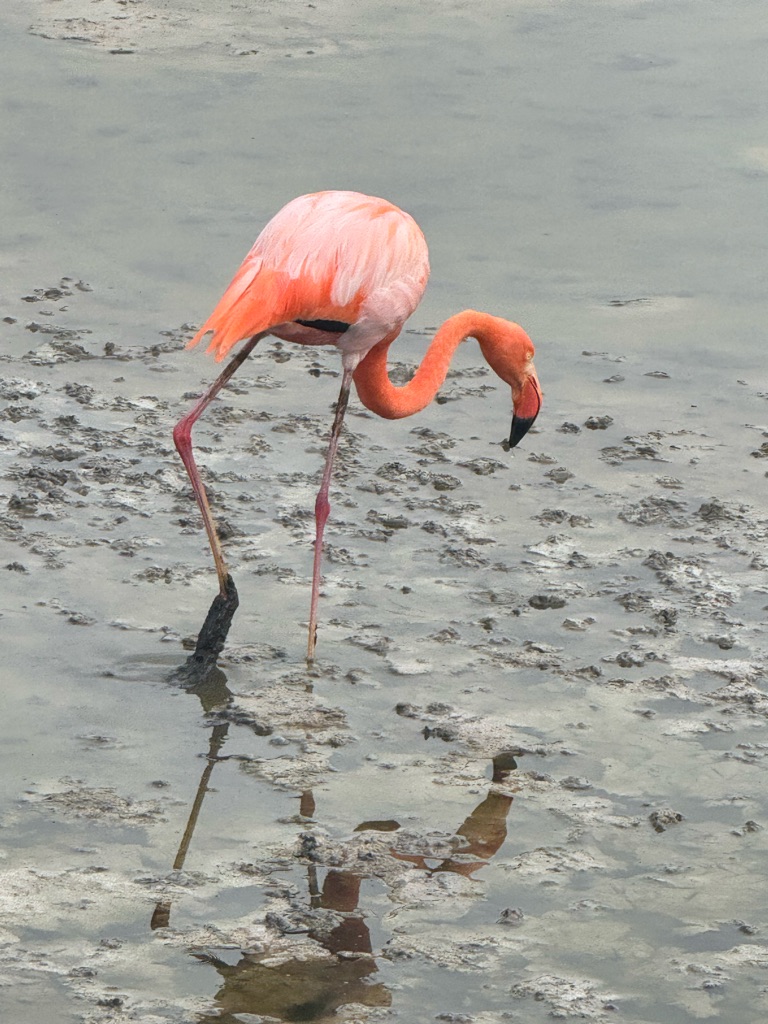


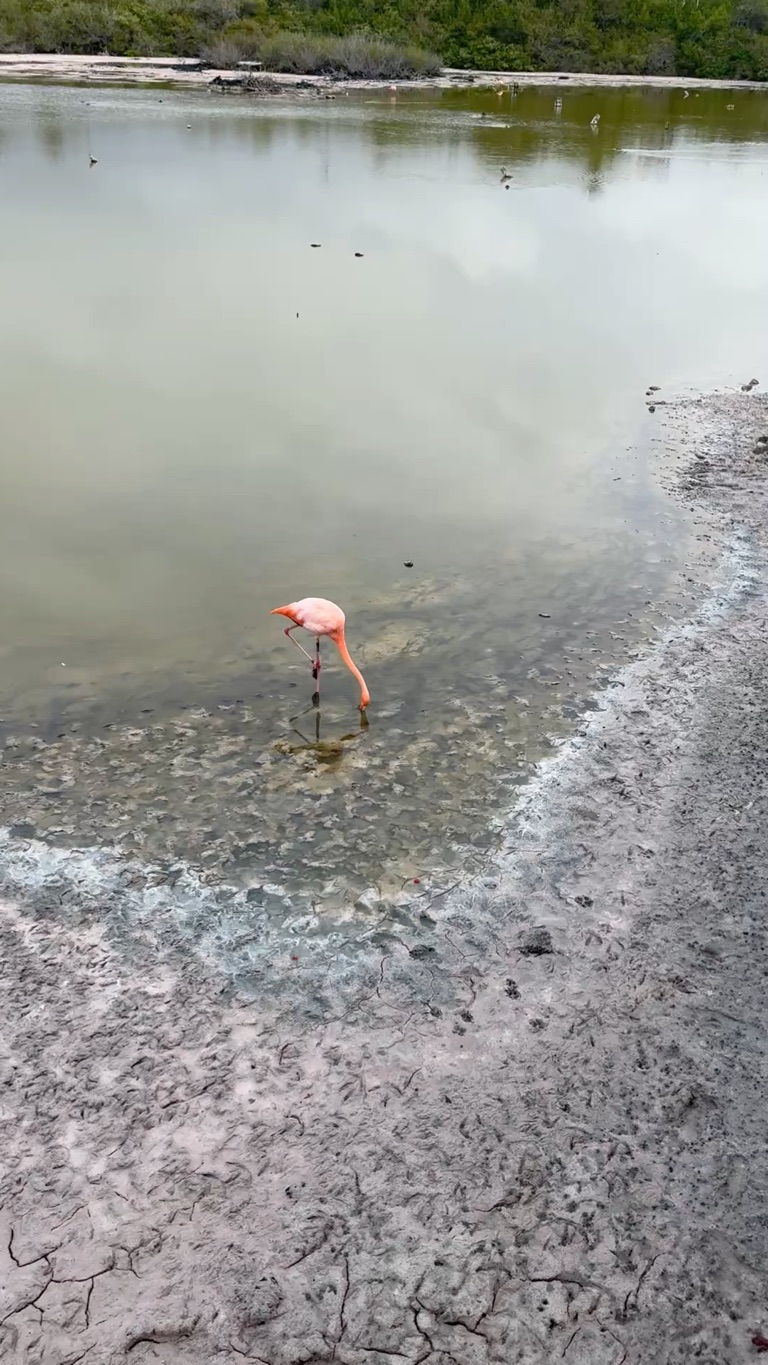
It’s off to the Galápagos tortoise breeding center at Villamil. We were fortunate to tour on feeding day. (They only feed them on M-W-F due to their slow metabolism). The center maintains about 20 breeding pairs. The eggs, once laid, are collected and artificially incubated. Giant Tortoises lay 8-16 eggs, much fewer than the 80-100 eggs that sea turtles lay. Turtle gender is determined by the temperature of incubation. In the wild, this is controlled by the heat of the sand and or location of the beach. However, with the incubator, the breeding center can control the counts of each sex. In the wild, turtle hatchlings live in the underground nest for up to a month, surviving on food and water stored in their bodies. The center replicates this process. \240Once the hatchling is ready to come out of the nest, the center carefully numbers their shell to indicate the species and the island they came from. The turtles then go into a nursery pen and are moved to larger pens as they grow. When they are about 5 years old, and are large enough to be safe from predators, they are released back into the wild on the island they came from.


The nursery pen

Feeding Time for the Big Guys

Male and female Breeders
The male tortoise is much larger than the female tortoise.


When we got back to the dock to catch our dingy back to the ship, we watched these wild sea lions showing off. Here they are climbing up the steps to another dock … and the people on the dock don’t appear to notice!

Up we go!
Santa Cruz - Puerto Aroyo
Our last afternoon was spent in Santa Cruz, home of the second largest city in the Galapagos with 22,000 people. We traveled to the highlands to view domed shelled giant tortoises in the wild. They were everywhere! Our guide, Diego, mentioned there were about 4000 on the island now, but before the 1700s when whalers and explorers started coming to the islands, there were over 50,000!

Dana and Tom Posing

Exhausted from his afternoon stroll

Dana as a Turtle!
The ranch had four tortoise shells on display. Dana tried on several and finally found the one that fit. It was not as comfortable as the beds that Goldie Locks tried! And it was way harder to get into!

Post Office
When whalers used to frequent the island, a barrel like this was used as a makeshift post office. Sailors would leave a message in a bottle addressed to their loved ones back at home or a mate where they were headed and place the bottles in and around the barrel. Other sailors would stop by, and if they were going to the destination of the bottle, they would take it with them and deliver the message. It might take months to years for a message to reach its intended recipient. This system was in use for 100 years!

Beth and Dana considering a plunge in the mud pool
Since tortoises are reptiles, their body is the same temperature as the outside temperature. When days are hot, they submerge themselves in mud pools to cool off. There was a lot of activity at the mud pools.

More mud pool activities!

Getting Jiggy With It - Turtle Style
It is mating season in the Galapagos, and we couldn’t leave without watching a 500lb male climb on top of a 130lb female and get to it. While the boobies we saw on the first day got it done in about 3 seconds, tortoises can take up to 90 minutes! And just to get the question on your mind out and answered, the male tortoise’s penis is in his tail!

These guys heard there was action going on in the fields so they wanted to eat and run!
We’re left Santa Cruz to start our 3 flights home this morning. But not before we got a few more pics!

Dana and Tom at Sunset on the M/Y Grace

Santa Cruz - early morning

Dana - the blue-footed boobie!

Catching a Snooze!
As we left our dinghy to change to the ferry that would take us to Baltra Island airport for our departure, we couldn’t resist this last pic of a sea lion. They are literally everywhere! Because they are protected, they have no fear of humans. And they certainly don’t mind taking up more than their fare share of bench space!



